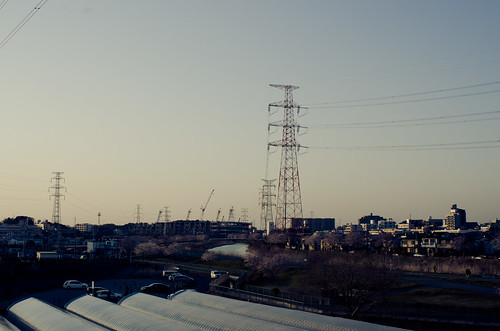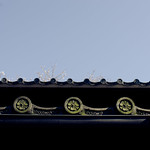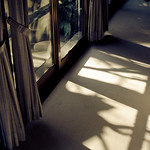1 And are, presumably, both heavily invested in tourism for their fiscal survival.
1, there seems to be a strong divide between those temples and shrines who have "figured it out" and those that haven't.That isn't to say that there is a "right" or a "wrong" way to posture oneself (either as devout or touristy), but that there are many that haven't quite decided what they want to be and then, painfully, try to be everything.
As we wandered the sublime halls of Kennin-ji (建仁寺), Kyoto's first Zen Buddhist temple, located just south of Gion (祇園) in the Higashiyama district of Kyoto (東山区、京都), in breathy whispers laden with guilt and shame, Junpei said it most succinctly: "everything here is a replica."

Granted, the original temple (like most everything in Kyoto
2 Which, singularly, is the reason it was not firebombed by the allies in WWII.
2) was founded in 1202 AD. As an active temple, Kennin-ji has been managed with great care, attempting to cultivate the grounds true to it's Zen roots while remembering to grow with an eye towards future, with new buildings added to the site in the 16th and 18th centuries.There is never a sense in most of these temples that history remains a force of stagnation. In fact, at virtually every shrine and temple we visited3, there were large building projects dotting the landscape. Really, the Toyota museum of technology in Nagoya seemed to be the only place we went that wasn't under some form of renovation.
Rather, historical reverence and practical progress seem to go hand-in-hand in Kyoto, a place where one block you may be wandering through blinding Karaoke halls, a confusing maze of love hotels and UFO-arcades, and the next you're weaving your way through maiko-laced streets lined with sakura bunting, listening to the soft metallic clink of 5円 pieces clattering through slats into wooden offering boxes.
In 2002, for it's 800th anniversary
4 I'll let that sink in…
4, Kennin-ji celebrated by "plussing" their grounds with a breathtaking ceiling piece called "双竜図" ("Souruyuzu," or "Twin Dragons") by master painter Junsaku Koizumi (who was 77 years old at the time of completion). This piece, at a stunning 11.4 x 15.7m, was installed in the main hall, the last Rinzaishu temple in all of Japan to feature such art work.Curiously, Masaaki Uematsu, the administrative president of the now 810 year-old temple, was quoted as saying "it looks as if the dragons have been here for more than hundreds of years."
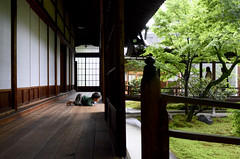


Personally, I find this tension fascinating. Everybody agrees that the history of a place (especially a place that's older than every currently existing codified constitutional government on the face of the earth) should be preserved. But how best should it be preserved?
Exactly as it appears today? Old, like Nijo Castle (二条城) and it's outlandish Ninomaru Palace Collection of 954 original 17th and 18th century Kanou-style woodcarvings and panel paintings
5 If their brochure is to be believed.
5 that speak to a legacy of craftsmanship that continues to cast its long shadow over culture today. Or as it was intended to be seen--and used--when it was first built, like Kennin-ji, with its painstakingly manicured Circle-Triangle-Square zen garden that just oozes with a transcendence that monks must have felt after their own arduous journeys from mountain villas to the Capitol of Tranquility and Peace. A living culture that doesn't just take you back 800 years but invites you to step into timelessnessIt's hard to know which model would best suit each
6 Except maybe in Nara where everything should probably just look old. And covered in deer poo.
6.Merely that it probably shouldn't be like the Kyoto Imperial Palace, which is wracked with so much self-importance that they won't even let tourists indulge in any immersive experiences, keeping them at arm's length, allowing them to mill about the outskirts of the imperial grounds, despite the site being completely reconstituted in the late 19th century and repurposed a number of times since, once even as military headquarters during WWII.
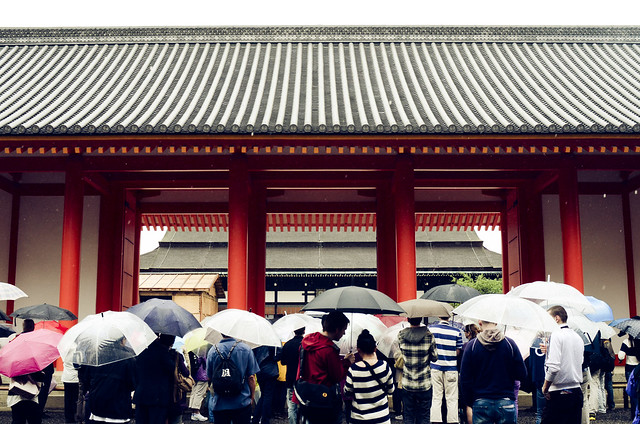
In some instances "reproduction" is is a dark little whisper smilingly hinted about in the corners of museums amongst friends, akin to the speculative Hollywood titter of "natural" or "surgically enhanced." And this certainly was the buzzword of our tours through both the Imperial Palace and Kennin-ji, as we giddily snapped away with our cameras (a feat expressly--reverentially--forbidden in the more delicate settings of Ninomaru and Sanjusangendo [三十三間堂]
7 A shrine famous for its 1001 statues of the Kannon, each with their 1000 arms… though, technically, they only have 42 arms, but if you multiply that by the 25-planes-of-existence that the Kannon exists in you get a nice, even 1000.
7).But it just didn't bother me at Kennin-ji.
In fact, I think I may put the fifteen minutes we spent contemplating the 潮音庭 near the top of my "would do again if I found myself back in Kyoto 9 months from now" list.
The Imperial Palace? Definitely not.
